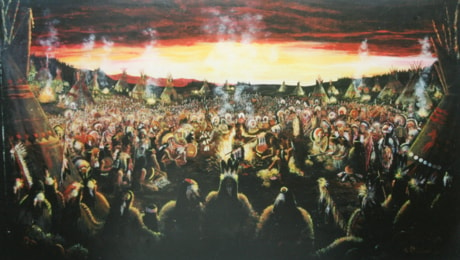Painting a historic moment for the Blackfoot First Nation was first suggested to Douglas Strickland back in 1970.
The Red Deer artist recalled it was his friend Nick Breaker, a champion chicken dancer from the Blackfoot tribe, who put it to him.
“We were talking about native history at the Crowfoot graveyard when Nick said, “For goodness sake, why not paint a picture of the peace treaty signing?” recalled Strickland.
Breaker had complained that not enough attention was paid to great moments in the history of his people, and Strickland agreed.
But Breaker was killed in a car accident a short while later and his idea was mentally filed away by the artist for more than three decades.
Then in 2004, Strickland, who is locally known for his authentic reproductions of aboriginal head dresses, moccasins and other handiwork, began thinking about his friend’s wish again.
He also remembered several other aboriginal friends lamenting how their rich culture and history were slipping away: “They told me, ‘This is my legacy. I don’t want this to be forgotten.’ ”
Strickland, now in his 70s, became motivated to begin researching and planning an ambitious artwork called Chief Crowfoot’s Peace Treaty Celebration.
He wanted his 106-cm-by-137-cm acrylic painting, depicting more than 20 teepees and 2,000 individuals, to have an epic feel.
While not of aboriginal heritage himself, Strickland said he didn’t want to focus on the treaty signing because then a federal government official would take centre stage.
His artwork instead depicts the celebratory gathering of tribes after the signing. Chief Crowfoot is at the centre, giving thanks to his medicine men, as a multitude of tribal members look on, in the dramatic moments before sunset.
The finished painting, listed at $20,000, hangs in the Gallery on Main in Lacombe. “The art is absolutely incredible,” said owner Laverne Jones, who would love the painting to stay in Alberta, preferably with a First Nations community.
But Strickland, nicknamed “Hawkeye” from a TV series of that name, doesn’t think this will happen.
Alberta First Nations groups generally feel white artists should steer clear of their culture, said Strickland, who was told as much by two aboriginal women who accused him of profiting off their heritage while he was selling handcrafted headdresses at the Calgary Stampede.
Celebrated Alberta writer W.P. Kinsella was similarly criticized for appropriating native culture for his short story collection Dance Me Outside and other books about the Hobbema reserves.
Not one for political correctness, Strickland said he wasn’t shy about responding to the two women that he has the same right to respectfully represent their culture as they have to wear non-aboriginal clothing, eat non-aboriginal food and enjoy many other aspects of mainstream Canadian culture.
He maintains he learned the art of beading and working with hides and feathers as a child from Mama Crow Foot, a kindly member of the Mi’kmaq First Nation, near his home in Nova Scotia. He credits this woman for looking after him for long stretches of his tumultuous childhood.
Strickland remembers his Aunt Alma, a strict Salvation Army worker, expressing great respect for Mama Crow Foot and other members of the Mi’kmaq tribe. “She told me, ‘You learn all you can from those people’ ” — and he did.
lmichelin@www.reddeeradvocate.com
